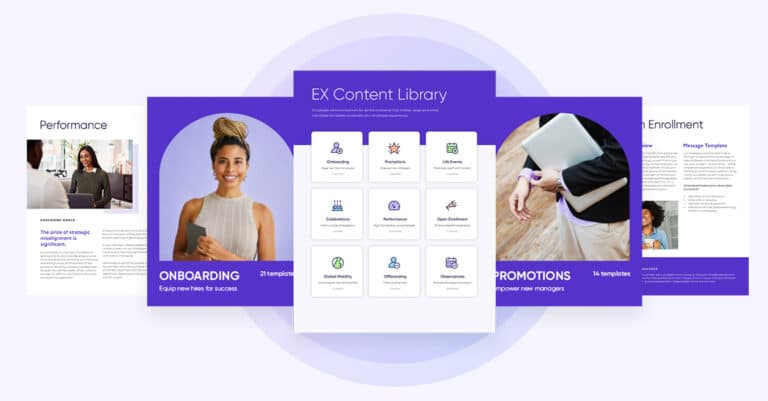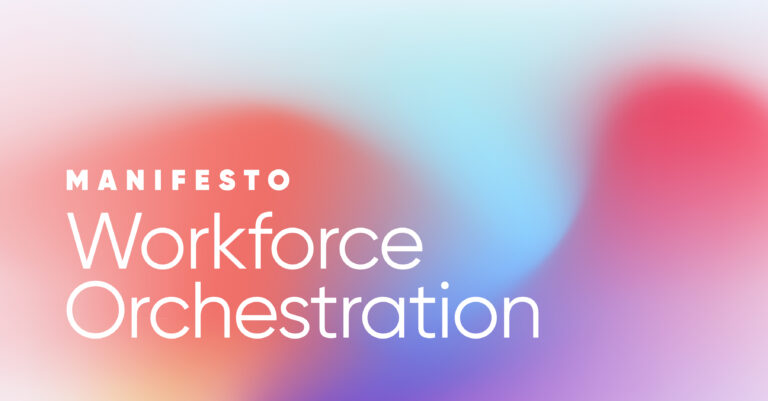Now that we have finished off 2021, we thought it would be a good time to take a look back at what was a crazy year. The continuing Covid pandemic, the “Great Resignation” supply chain disruptions, a near-all-time-low unemployment rate, and entire industries going remote often take center stage in the business headlines. And that’s not even the craziest stuff. Remember when the Suez Canal was blocked?!
But a key silver lining (because we need as many of those as we can) has been the renewed interest and respect for internal communications. The ability for a company to continue to successfully operate in the face of adversity depends on employees knowing what the hell is going on in where they work.
With that in mind, I wanted to take the pulse of leading voices in internal communications to get their take on what was overlooked and needs more focus this year? But also what was overhyped and received too much attention?
Let’s take a look at what they had to say…

Mike Klein, Principal, Changing the Terms
Overlooked: The fundamentally different nature of remote-first IC and office-based IC and how technology can enable each.
Overhyped: Hybrid—which muddies the waters rather than allowing for clear insight into how work will really change.

Caitlin Brady, Strategy Advisor, Firstup
Overlooked: Importance of spreading joy and fun. We dealt with a lot of heavy topics throughout 2021, but we cannot forget the importance of making our employees smile. Celebrate things like World Kindness Day and rally teams around fun user-generated content contests, like submitting cute pet photos.
Overhyped: Trying to be perfect and have all the answers when it comes time to communicate about COVID vaccines and new mandates. It is better to share communication that says “we saw the new mandate and are still evaluating what that means for us,” instead of creating a lengthy communication outlining all possible scenarios or holding on sending a communication until you had new information to share.

Amanda Daniel Monroe, HR Consultant
Overlooked: Really celebrating organizations that pivoted due to covid but also flourished in the long run because of the humanity that they brought to their organizations.
Overhyped: The Great Resignation—too much fantastical ruminations, not enough critique and change to systemic systems that fed into the Great Resignation.
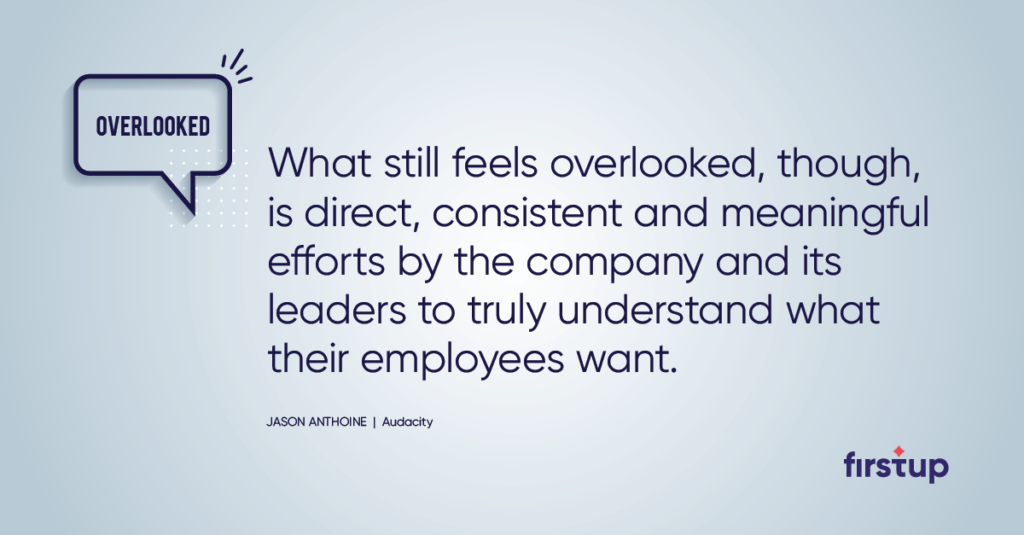

Jason Anthoine, Head Honcho, Audacity
Overlooked: As always, there’s a serrated edge between what companies offer and what employees expect. Despite that, though, there has been a good bit of effort on both sides over the past year to help soften those sharp edges in an attempt to move closer together. What still feels overlooked, though, is direct, consistent and meaningful efforts by the company and its leaders to truly understand what their employees want. It feels like most companies simply Google for ideas or attend a few lunches and learn webinars to figure out what everyone else is doing so they can then do it too. This leads to one-size-fits-none solutions that may be trendy and safe but that don’t truly take into account how unique each company’s culture is. A better approach would be to still Google and attend webinars and do whatever else it is you do to stay current with trends but then present all of those ideas and potential solutions to employees before implementing any of them. Start a discussion, collaborate, build on ideas, shave off the silly stuff, question, test, iterate, simplify: do all of these things together to arrive at good solutions that are as unique and special as your own culture. This applies equally to IC, HR, IT, Ops and the rest of the corporate functions alphabet.
Overhyped: Hmmmm…everything? I know that’s a cop-out because it isn’t specific and probably not very helpful, on the surface. But there is a truism there: if everything is hyped to the max, then what is truly important? If all things are A+#1, then which one is truly first among equals? We can reach pretty much all employees all the time with everything that ever needs to be communicated. But just because we can doesn’t mean we should. We (IC) should be more selective about all of our comms, which includes pushing back on leaders and functions who all insist that their stuff is A+#1. Nope. It isn’t. Help them all decide what truly is so a) they can be better communicators themselves and b) we can protect employees from all that noise. Sometimes our job is to protect leaders and companies from themselves. Thank goodness.

Rachel Miller, Founder, All Things IC
Overlooked: How leaders needed to adapt their communication style, including preparing leaders to present effectively via online platforms.
Overhyped: Work as a place you go, rather than a thing you do. Too much attention has been given to location, rather than addressing the cultural impact and required changes.
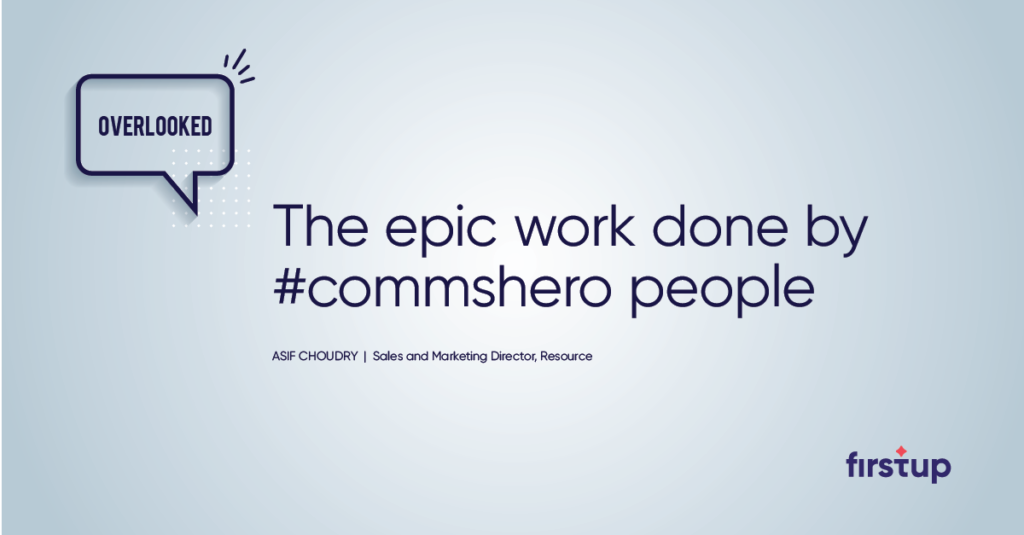

Asif Choudry, Sales and Marketing Director, Resource
Overlooked: The epic work done by #commshero people. The value of comms has been taken for granted for many years and during 2021 the continuing push to get more and more out of comms teams that are already facing burnout and suffering from mental health. Expecting them to be available on-call ‘just because they are working from home’. Be more focused on staying connected with colleagues and not think that spending time with them on endless teams or zoom calls achieves this. GIVE THEM SOME SCREEN BREAKS and maybe even communicate with them in print sometimes.
Overhyped: The fact that remote/hybrid working would see the transition to work/life balance. If anything, it has brought the opposite for many with issues for some in making the distinction between work and social life (it’s hard when your commute is from upstairs to the dining table/home office). The harsh reality for many is that they’ll never get used to it or find the balance. I hear of many people who have missed the commute as that was their downtime to know that work had ended and social time had begun.

Kristin Hancock, VP, Community & Engagement, ICology
Overlooked: The root cause of culture issues.
Overhyped: “Rewarding” employees with mental health resources and wellness activities (rather than focusing on the cause of burnout in the first place).

Becky Graebe, Sr Strategy Director, Firstup
Overlooked: Retention Efforts. While there was a lot of necessary focus on hiring and filling open job positions in the wake of the Great Resignation, we likely overlooked opportunities to listen to employees who made a conscious decision to stay, with questions such as:
- What aspects of the company culture do you appreciate most?
- What resources, benefits, approaches to work are you finding most helpful right now?
- What needs attention?
- When have you felt most valued and appreciated (and the opposite)?
- Do you feel you have opportunities for growth and encouragement to explore them?
- If you could change one thing about work right now, what would it be?
Overhyped: Definitive Target Dates for Return-to-Office. We spent a lot of time and energy determining what these should be and who they would impact only to see them move out time and time again. Now a lot of organizations are shifting to an approach that simply lets employees know they will be working this way until it makes sense for the organization to consider something different (and at that point, they will offer plenty of notice and options when possible). When employees asked for clarity, we probably overhyped the need for a return date when they likely would have been ok understanding the decision-making process.

Brittany Barhite, Employee Experience Manager, Firstup
Overlooked: I think we should have talked to the employees staying at companies and ask them why they are staying. We focused a lot on “the great resignation” and it was warranted. However, did we have conversations with our employees that were staying and ask them, “why?” Did we do stay interviews?
Overhyped: We talked a lot about office workers being remote, but what about those workers who always had to come in (service, retail, medical, etc.). What type of communication and engagement do they need?

Lisa Yeaton, Social Media Manager, Extreme Networks
Overlooked: Employee engagement and activation. The great resignation is happening. Employers are losing employees and paying premiums to bring in replacements. The importance of employee engagement and activation cannot be overstated. Engagement and activation are key to not only retaining and recruiting employees but also increasing brand awareness and generating new leads. Engaged employees stay, and when they’re activated they become brand advocates. Studies show a 700% greater conversion rate when leads are developed through personal social accounts rather than business pages, and employee-generated content sees 8x more engagement than content posted on corporate social accounts.
Overhyped: Video content is huge, but what is often overhyped is the level of quality. Every video does not need to be a costly, high-quality production. Brand transparency and authenticity are top of mind for customers and employees. Quality is still important, but there is a spectrum and short, authentic, selfie videos from key executives can work just as well as expensive, flashy ads. It’s not necessary to shoot every video in a studio with expensive cameras. Be agile and authentic. As long as your content is authentic, engagement will follow.

Shauna Fields, Senior Manager, Internal Communications, GoDaddy
Overlooked: The need for c-suite ownership of the digital workplace and internal communications.
Overhyped: Ways to engage teams remotely OR replicate in-office experiences, without actually addressing systemic issues causing burnout through the pandemic.

Steve Crescenzo, CEO, Crescenzo Communications
Overlooked: Manager Communications. We all love to help our executives communicate (if we’re smart, that is, and willing to speak truth to power). But, in reality, about 80 percent of the communications in any company falls to the front-line supervisors and managers. And those people were sideswiped by Covid, and from what I heard and saw at the dozens of virtual conferences and workshops I spoke at or led, far too many companies hung them out to dry.
Overhyped: The opportunity for employee communicators to become true strategic partners, because Covid has moved communications to the forefront. Smart communicators have ALWAYS been strategic partners because communications should ALWAYS be at the forefront. I heard a saying once that hit home for me: Communications moves employees. Employees move companies. I don’t know who first said it, but it was spot on.

Joey Nord, Senior Director, Corporate Communications & PR, Ciox
Overlooked: I think we underestimated the impact of supply chain issues on our business and how a lack of quick/ready access to goods, tools, etc. would affect how people work and get things done. (specifically, how much lead time is now required for everything from event management to IT hardware support)
Overhyped: I think we “overhyped” the impact of work from home—not because it didn’t have a significant impact but because the dramatic adjustment happened in 2020 and most people had figured their way around it by 2021. Employers who tried to get their employees to return to an in-office environment in 2021 were met with cries of “Why? I’m already successfully delivering from home.”

AJ O’Leary, Digital Communications Specialist, Firstup
Overlooked: Accessibility – as communicators, we always need to design content with our *entire* audience in mind, paying attention to all their needs. Whether it’s including captions with videos or avoiding certain color combinations for assets, we must always cast the widest net possible.
Overhyped: Variety for the sake of variety—if it isn’t broke, don’t fix it! It’s good to try new things and pay attention to trends, but if a messaging strategy/content cadence is delivering results above and beyond a team’s goals, there’s no harm nor shame in continuing what works.

Debbie West, Seren Creative Ltd.
Overlooked: There have been some very helpful resources shared this year, to help us improve the accessibility of our communications. One example for the UK is the PRCA’s Accessible Communications Guidelines. I haven’t seen a lot of discourse around that and I wonder what proportion of the communications community are adopting the recommendations. I will be the first to say I have a lot to learn about this too, and even the simple things I’ve tried to do, I don’t always apply consistently. For example, I started to type each of the words in hashtag phrases with capital letters, to make them understandable to screen readers, but sometimes I forget and resort to the default phrases. It’s a pattern of good but inconsistent intentions I see with people I follow and work with too. I think it’s an area we could be paying more attention to, to ensure the greatest equity of communication we can to our communities.
Overhyped: This is a much trickier question to answer! I think the excitement and dialogue we see around certain topics gather there because those are the immediate concerns people have. That being said, the debate about the phrase ‘hybrid working’ that has continued throughout the year has helped me think about the effect labels can have on the way we perceive things. Certainly, the pandemic has triggered a huge acceleration in the rate at which more people have needed to work from home for part or most, of the time. But this is a trend that was already underway and many communicators have worked for many years to highlight and resolve the challenges of reaching dispersed, remote, or ‘deskless’ workers. There is certainly a need for us to consider how to manage the realities of an uncertain future for the ways we work and communicate, including the increased rate of hybrid working patterns in some sectors. We should also take care not to allow the labels that arise in our conversations to prevent us from thinking more broadly.

Cindy Crescenzo, President, Crescenzo Communications
Overlooked: Measuring behavior. When we are crafting our content and communication campaigns, we need to give ourselves more time to *think* about what we want our audiences to Know, Feel and Do as a result of our communications/content. When we do that, we start to define measurable behaviors we need to fuel an effective communication strategy. Too often, we don’t give ourselves time to define our desired outcomes ahead of time … and true communication measurement falls to the wayside.
Overhyped: Metrics. Yep, I said that out loud. We have SO MANY great metrics coming from our tools like First Up … BUT… we can’t just rely on these metrics alone and say we’re ‘measuring’ our communications. Metrics are extremely important … but only part of the picture. It’s only when we can link behaviors to those metrics when we are getting the full picture and fully understanding if we’re doing what we’re supposed to be doing as communicators: influencing behavior in a positive way.
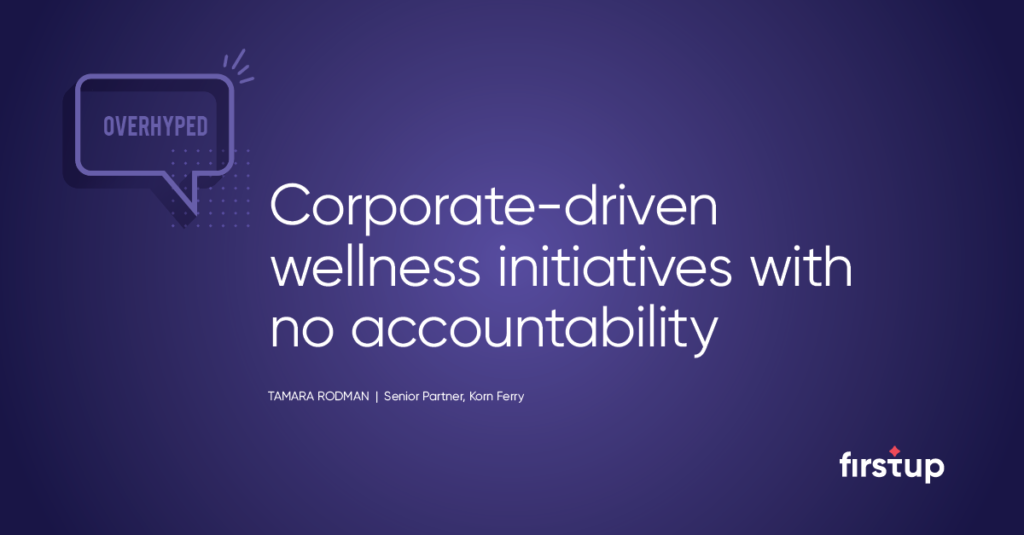

Tamara Rodman, Senior Partner, Korn Ferry
Overlooked: Onboarding! The potential implications of overlooking the long-neglected bridge between a company’s EVP (employee value proposition) and lived employee experience will become apparent over the next six months, when Big Quit-associated new hires assess the extent to which they feel effective and connected within their new organization.
Overhyped: Corporate-driven wellness initiatives with no accountability nor support for managers to enable greater balance. Line managers have an outsized impact on employees’ experience, workload and flexibility. Many employers introduced centrally led efforts that sounded great on paper but fell flat because managers held their teams to pre-pandemic standards or felt pressure themselves to perform no matter what.
Conclusion
We have no crystal ball. It would be amazing if we did though. My advice to communicators is to trust your gut. You’ll be right more than you’re not. You’re in such a unique position to lead.
There’s been a renewed focus by companies on internal communications during the pandemic. But I know you’ve been on the inside doing this work the whole time. Keep it up.










